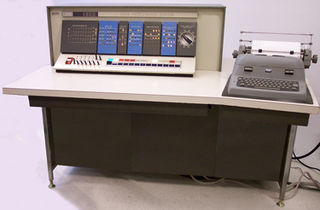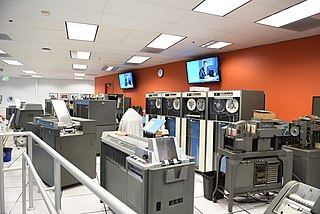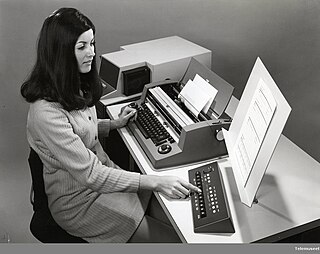
The IBM System/360 (S/360) is a family of mainframe computer systems announced by IBM on April 7, 1964, and delivered between 1965 and 1978. They were the first family of computers designed to cover both commercial and scientific applications and a complete range of applications from small to large. The design distinguished between architecture and implementation, allowing IBM to release a suite of compatible designs at different prices. All but the only partially compatible Model 44 and the most expensive systems use microcode to implement the instruction set, featuring 8-bit byte addressing and fixed point binary, fixed point decimal and hexadecimal floating-point calculations.

A word processor is an electronic device for text, composing, editing, formatting, and printing.

Punched tape or perforated paper tape is a form of data storage device that consists of a long strip of paper through which small holes are punched. It was developed from and was subsequently used alongside punched cards, the difference being that the tape is continuous.

The IBM 1620 was announced by IBM on October 21, 1959, and marketed as an inexpensive scientific computer. After a total production of about two thousand machines, it was withdrawn on November 19, 1970. Modified versions of the 1620 were used as the CPU of the IBM 1710 and IBM 1720 Industrial Process Control Systems.

The IBM 1401 is a variable-wordlength decimal computer that was announced by IBM on October 5, 1959. The first member of the highly successful IBM 1400 series, it was aimed at replacing unit record equipment for processing data stored on punched cards and at providing peripheral services for larger computers. The 1401 is considered by IBM to be the Ford Model-T of the computer industry due to its mass appeal. Over 12,000 units were produced and many were leased or resold after they were replaced with newer technology. The 1401 was withdrawn on February 8, 1971.

The IBM 650 Magnetic Drum Data-Processing Machine is an early digital computer produced by IBM in the mid-1950s. It was the first mass-produced computer in the world. Almost 2,000 systems were produced, the last in 1962, and it was the first computer to make a meaningful profit. The first one was installed in late 1954 and it was the most popular computer of the 1950s.

The IBM 632 was a valve-and-relay driven basic accounting machine, introduced in 1958, that was available in seven different models. It consisted of an IBM Electric typewriter and at least a punched card unit that housed the "electronics" in two gates. Some machines also had a card reader unit. A small core memory provided storage for 8 numeric 12 digit words.

The IBM 1440 computer was announced by IBM October 11, 1962. This member of the IBM 1400 series was described many years later as "essentially a lower-cost version of the 1401", and programs for the 1440 could easily be adapted to run on the IBM 1401.

Starting at the end of the nineteenth century, well before the advent of electronic computers, data processing was performed using electromechanical machines collectively referred to as unit record equipment, electric accounting machines (EAM) or tabulating machines. Unit record machines came to be as ubiquitous in industry and government in the first two-thirds of the twentieth century as computers became in the last third. They allowed large volume, sophisticated data-processing tasks to be accomplished before electronic computers were invented and while they were still in their infancy. This data processing was accomplished by processing punched cards through various unit record machines in a carefully choreographed progression. This progression, or flow, from machine to machine was often planned and documented with detailed flowcharts that used standardized symbols for documents and the various machine functions. All but the earliest machines had high-speed mechanical feeders to process cards at rates from around 100 to 2,000 per minute, sensing punched holes with mechanical, electrical, or, later, optical sensors. The operation of many machines was directed by the use of a removable plugboard, control panel, or connection box. Initially all machines were manual or electromechanical. The first use of an electronic component was in 1937 when a photocell was used in a Social Security bill-feed machine. Electronic components were used on other machines beginning in the late 1940s.

The Friden Flexowriter was a teleprinter produced by the Friden Calculating Machine Company. It was a heavy-duty electric typewriter capable of being driven not only by a human typing, but also automatically by several methods, including direct attachment to a computer and by use of paper tape.

A keypunch is a device for precisely punching holes into stiff paper cards at specific locations as determined by keys struck by a human operator. Other devices included here for that same function include the gang punch, the pantograph punch, and the stamp. The term was also used for similar machines used by humans to transcribe data onto punched tape media.

The Bendix G-15 is a computer introduced in 1956 by the Bendix Corporation, Computer Division, Los Angeles, California. It is about 5 by 3 by 3 feet and weighs about 966 pounds (438 kg). The G-15 has a drum memory of 2,160 29-bit words, along with 20 words used for special purposes and rapid-access storage. The base system, without peripherals, cost $49,500. A working model cost around $60,000. It could also be rented for $1,485 per month. It was meant for scientific and industrial markets. The series was gradually discontinued when Control Data Corporation took over the Bendix computer division in 1963.

The IBM 610 Auto-Point Computer is one of the first personal computers, in the sense of a computer to be used by one person whose previous experience with computing might only have been with desk calculators. It was controlled interactively by a keyboard. The principal designer of this machine was John Lentz, as part of his work for the Watson Lab at Columbia University.

The IBM MT/ST was a model of the IBM Selectric typewriter, built into its own desk, integrated with magnetic tape recording and playback facilities, located in an attached enclosure, with controls and a bank of relays. It was released by IBM in 1964. It recorded text typed on 1/2" magnetic tape, approximately 25 kilobytes per tape cassette, and allowed editing and re-recording during playback. It was the first system marketed as a word processor. Most models had two tape drives, which greatly facilitated revision and enabled features such as mail merge. An add-on module added a third tape station, to record the combined output of playback from the two stations.

From the invention of computer programming languages up to the mid-1970s, most computer programmers created, edited and stored their programs line by line on punch cards.

The NCR 315 Data Processing System, released in January 1962 by NCR, is a second-generation computer. All printed circuit boards use resistor–transistor logic (RTL) to create the various logic elements. It uses 12-bit slab memory structure using magnetic-core memory. The instructions can use a memory slab as either two 6-bit alphanumeric characters or as three 4-bit BCD digits. Basic memory is 5000 "slabs" of handmade core memory, which is expandable to a maximum of 40,000 slabs in four refrigerator-size cabinets. The main processor includes three cabinets and a console section that houses the power supply, keyboard, output writer, and a panel with lights that indicate the current status of the program counter, registers, arithmetic accumulator, and system errors. Input/Output is by direct parallel connections to each type of peripheral through a two-cable bundle with 1-inch-thick cables. Some devices like magnetic tape and the CRAM are daisy-chained to allow multiple drives to be connected.

The CDC 160 series was a series of minicomputers built by Control Data Corporation. The CDC 160 and CDC 160-A were 12-bit minicomputers built from 1960 to 1965; the CDC 160G was a 13-bit minicomputer, with an extended version of the CDC 160-A instruction set, and a compatibility mode in which it did not use the 13th bit. The 160 was designed by Seymour Cray - reportedly over a long three-day weekend. It fit into the desk where its operator sat.

The RCA Spectra 70 is a line of electronic data processing (EDP) equipment that was manufactured by the Radio Corporation of America’s computer division beginning in April 1965. The Spectra 70 line included several CPU models, various configurations of core memory, mass-storage devices, terminal equipment, and a variety of specialized interface equipment.

IBM designed, manufactured and sold optical mark and character readers from 1960 until 1984. The IBM 1287 is notable as being the first commercially sold scanner capable of reading handwritten numbers.




















